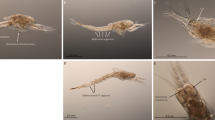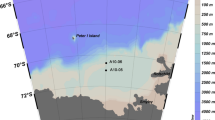Abstract
Antarctic krill (Euphausia superba) is a key species in Antarctic marine ecosystems, as well as an important species in the Southern Ocean fishery. Here, we provide the first detailed photographic documentation of embryonic and larval development of Antarctic krill over a 5-month developmental period under controlled laboratory conditions. Developing embryos and larvae were photographed every 3 h and every 5 days, respectively. Our results indicated a developmental time of approximately 6 days for embryos and 138 days for larvae (0.5 °C). This study provided baseline biometry information for future investigations of Antarctic krill development under changing environmental conditions.












Similar content being viewed by others
References
Brinton E, Huntley M, Townsend AW (1986) Larvae of Euphausia superba in the Scotia Sea and Bransfield Strait in March 1984—development and abundance compared with 1981 larvae. Polar Biol 5:221–234
Daly KL (2004) Overwintering growth and development of larval Euphausia superba: an interannual comparison under varying environmental conditions west of the Antarctic Peninsula. Deep Sea Res II 51:2139–2168
Feinberg LR, Tracy Shaw C, Peterson WT (2006) Larval development of Euphausia pacifica in the laboratory: variability in developmental pathways. Mar Ecol Prog Ser 316:127–137
Flores H, Atkinson A, Kawaguchi S, Krafft BA, Milinevsky G, Nicol S, Reiss C, Tarling GA, Werner R, Bravo Rebolledo E, Cirelli V, Cuzin-Roudy J, Fielding S, Groeneveld JJ, Haraldsson M, Lombana A, Marschoff E, Meyer B, Pakhomov EA, Rombolá E, Schmidt K, Siegel V, Teschke M, Tonkes H, Toullec JY, Trathan PN, Tremblay N, Van de Putte AP, van Franeker JA, Werner T (2012) Impact of climate change on Antarctic krill. Mar Ecol Prog Ser 458:1–19
Fraser FC (1936) On the development and distribution of the young stages of Krill (Euphausia superba). Discov Rep 14:1–192
Frazer TK, Quetin LB, Ross RM (2002) Energetic demands of larval krill, Euphausia superba, in winter. J Exp Mar Biol Ecol 277:157–171
García-Guerrero M, Hendrickx ME (2006) Embryology of decapod crustaceans III: embryonic development of Eurypanopeus canalensis Abele & Kim, 1989, and Panopeus chiensis H. Milne Edwards & Lucas, 1844 (Decapoda, Brachyura, Panopeidae). Belg J Zool 136:249–253
George RY, Strömberg J-O (1985) Development of eggs of Antarctic krill Euphausia superba in relation to pressure. Polar Biol 4:125–133
Gómez-Gutiérrez J, Peterson WT, Miller CB (2010) Embryo biometry of three broadcast spawning euphausiid species applied to identify cross-shelf and seasonal spawning patterns along the Oregon coast. J Plankton Res 32:739–760
Harrington SA, Ikeda T (1986) Laboratory observations on spawning, brood size and egg hatchability of the Antarctic krill Euphausia superba from Prydz Bay, Antarctica. Mar Biol 92:231–235
Harrington SA, Thomas PG (1987) Observations on spawning by Euphausia crystallorophias from waters adjacent to Enderby Land (East Antarctica) and speculations on the early ontogenetic ecology of neritic euphausiids. Polar Biol 7:93–95
Ikeda T (1984) Development of the larvae of the Antarctic krill (Euphausia superba Dana) observed in the laboratory. J Exp Mar Biol Ecol 75:107–117
Kawaguchi S, King R, Meijers R, Osborn JE, Swadling KM, Ritz DA, Nicol S (2010) An experimental aquarium for observing the schooling behaviour of Antarctic krill (Euphausia superba). Deep Sea Res II 57:683–692
Kawaguchi S, Kurihara H, King R, Hale L, Berli T, Robinson JP, Ishida A, Wakita M, Virtue P, Nicol S, Ishimatsu A (2011) Will krill fare well under Southern Ocean acidification? Biol Lett 7:288–291
Kawaguchi S, Ishida A, King R, Raymond B, Waller N, Constable A, Nicol S, Wakita M, Ishimatsu A (2013) Risk maps for Antarctic krill under projected Southern Ocean acidification. Nat Clim Chang. doi:10.1038/nclimate1937
King R, Nicol S, Cramp P, Swadling KM (2003) Krill maintenance and experimentation at the Australian Antarctic Division. Mar Fresh Behav Physiol 36:271–283
Kirkwood JM (1982) A guide to the Euphausiacea of the Southern Ocean. ANARE Res Notes 1:1–45
Marr JWS (1962) The natural history and geography of the Antarctic krill (Euphausia superba Dana). Discov Rep 32:33–464
Marschall HP (1983) Sinking speed, density and size of Euphausiid eggs. Meeresforsch 30:1–9
Marschall HP, Hirche HJ (1984) Development of eggs and nauplii of Euphausia superba. Polar Biol 2:245–250
Mauchline J (1988) Egg and brood sizes of oceanic pelagic crustaceans. Mar Ecol Prog Ser 43:251–258
McWhinnie MA, Denys CJ (1978) Biological studies of Antarctic krill, austral summer, 1977–1978. Antarct J US 13:133–135
Meyer B (2012) The overwintering of Antarctic krill, Euphausia superba, from an ecophysiological perspective. Polar Biol 35:15–37
Meyer B, Atkinson A, Stübing D, Oettl B, Hagen W, Bathmann UV (2002) Feeding and energy budgets of Antarctic krill Euphausia superba at the onset of winter-I. Furcilia III larvae. Limnol Oceanogr 47:943–952
Meyer B, Fuentes V, Guerra C, Schmidt K, Atkinson A, Spahic S, Cisewski B, Freier U, Olariaga A, Bathmann U (2009) Physiology, growth, and development of larval krill Euphausia superba in autumn and winter in the Lazarev Sea, Antarctica. Limnol Oceanogr 54:1595–1614
Nicol S, Virtue P, King R, Davenport SR, McGaffin AF, Nichols P (2004) Condition of Euphausia crystallorophias off East Antarctica in winter in comparison to other seasons. Deep Sea Res II 51:2215–2224
Quetin LB, Ross RM (1984) Depth distribution of developing Euphausia superba embryos, predicted from sinking rates. Mar Biol 79:47–53
Quetin LB, Ross RM, Frazer TK, Haberman KL (1996) Factors affecting distribution and abundance of zooplankton, with an emphasis on Antarctic krill, Euphausia superba. Antarct Res Ser 70:357–371
Ross RM, Quetin LB (1982) Euphausia superba: fecundity and physiological ecology of its eggs and larvae. Antarct J US 17:166–167
Ross RM, Quetin LB (1989) Energetic cost to develop to the first feeding stage of Euphausia superba Dana and the effect of delays in food availability. J Exp Mar Biol Ecol 133:103–127
Ross RM, Quetin LB (1991) Ecological physiology of larval euphausiids, Euphausia superba (Euphausiacea). Mem Qld Mus 31:321–333
Ross RM, Quetin LB, Kirsch E (1988) Effect of temperature on developmental times and survival of early larval stages of Euphausia superba Dana. J Exp Mar Biol Ecol 121:55–71
Tarling GA, Cuzin-Roudy J, Wootton K, Johnson ML (2009) Egg-release behavior in Antarctic krill. Polar Biol 32:1187–1194
Whiteley NM (2011) Physiological and ecological responses of crustaceans to ocean acidification. Mar Ecol Prog Ser 430:257–271
Yoshida T, Toda T, Hirano Y, Matsuda T, Kawaguchi S (2004) Effect of temperature on embryo development time and hatching success of the Antarctic krill Euphausia superba Dana in the laboratory. Mar Fresh Behav Physiol 37:137–145
Yoshida T, Virtue P, Kawaguchi S, Nichols PD (2011) Factors determining the hatching success of Antarctic krill Euphausia superba embryo: lipid and fatty acid composition. Mar Biol 158:2313–2325
Acknowledgments
We thank Dr. B. Meyer, Dr. J. Cuzin-Roudy, and an anonymous reviewer for their constructive comments. We also thank Dr. J. Melbourne-Thomas for critical reading of the early draft of this manuscript. R. King, T. Waller, D. Lang, and J. Mclvor deserve special thanks for their supports and maintenance of the krill aquarium at the Australian Antarctic Division. Funding was partially provided by Holsworth wildlife research endowment.
Author information
Authors and Affiliations
Corresponding author
Rights and permissions
About this article
Cite this article
Jia, Z., Virtue, P., Swadling, K.M. et al. A photographic documentation of the development of Antarctic krill (Euphausia superba) from egg to early juvenile. Polar Biol 37, 165–179 (2014). https://doi.org/10.1007/s00300-013-1420-7
Received:
Revised:
Accepted:
Published:
Issue Date:
DOI: https://doi.org/10.1007/s00300-013-1420-7




